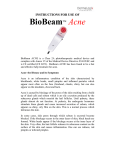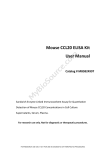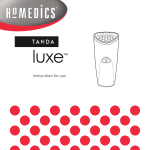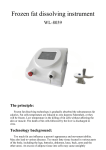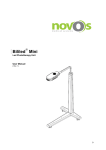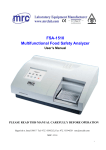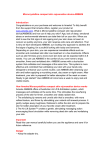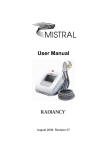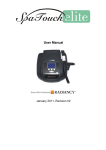Download Mistral_soriasis protocol
Transcript
OPERATION AND TREATMENT PROTOCOLS psoriasis have this type. Plaque psoriasis can appear on any skin surface, although the knees, elbows, scalp, trunk and nails are the most common locations. Figure 29: Plaque Psoriasis 4.8.3. Indications The Mistral PSOR handpiece is intended to provide phototherapeutic light to the body. The Mistral PSOR handpiece is generally indicated to treat dermatological conditions and is specifically indicated to treat mild and moderate plaque psoriasis, which includes the treatment of patients with Fitzpatrick skin types I-VI. x x x x 4.8.4. Contraindications Under 18 years of age Are pregnant or lactating Have tanned by sun or artificial tanning machine within the last 21 days. x Have a tattoo or permanent makeup in the treatment area. x diabetes or other diseases. x psoriasis in the treatment area. Have a history of abnormal skin conditionsdue, for example, to Have a history of inflammatory skin conditions other than x Have a history of local skin infections. x 6 months Have been treated with isotrentinoin (Accutane) within the past Have used any medications, herbal preparations or chemicals that cause photosensitivity within the last 6 weeks. These Mistral User Manual 67 CHAPTER 4 include, but are not limited to, gold therapy, tetracycline or sulfa drugs and certain psychiatric medications. In case of uncertainty regarding photosensitivity side effects, x x have the patient consult their physician. Suffer from epilepsy. Have diseases related to photosensitivity, such as Porphyria, Polymorphic Light Eruption, Solar Urticaria, Lupus and other x autoimmune diseases. Have a history of herpes outbreaks, unless the patient has consulted their physician and received prophylaxis treatment x prior to treatment. x potential skin malignancies. Have a history of skin cancer or patients who have areas of Have received chemotherapy or radiotherapy treatments within the past 5 years should not be treated without their acting x x x physician's consent. Have been on s steroids regimen (e.g. asthma) over the last 3 months Have an active implant, such as a pacemaker, incontinence device, insulin pump, etc. Have any other condition which in the practitioner’s opinion would make it unsafe for them to be treated 4.8.5. Pre-Treatment Considerations During the initial client visit, the LHE® psoriasis practitioner should assess the areas to be treated and address the following issues: x x Verify that the client does not meet any of the exclusion criteria. x with the treatment. Inform the client that there may be some discomfort associated Inform the client that transient erythema, edema or blistering may appear immediately after treatment. 68 Revision A10, November 2012 OPERATION AND TREATMENT PROTOCOLS x Inform the client that LHE® psoriasis treatment involves several sessions and that he or she should be willing to complete the x full treatment course. Inform the client that there is a small risk of possible adverse side effects such as changes in texture and hypo-or hyperpigmentation of the skin and that these changes are usually x transient. If you chose to add salicylic-acid in combination with the treatment regime ,make sure that the patient uses it on a regular daily basis during the entire treatment course. The salicylic acid should be applied a few hours from the treatment, x preferably before the treatment administration . Have the client sign your consent form prior to treatment 4.8.6. Pre-Treatment Preparation 1 Clean - Clean the treatment area to remove any dirt or makeup. DO NOT USE ALCOHOL OR ACETONE!! 2 Dry - Dry the skin surface to be treated. NEVER ALLOW ANYTHING WET NEAR THE TREATMENT AREA!! 3 Cover – Cover the surrounding, healthy skin tissue with a white sticker. DO NOT USE FLAMMABLE MATERIAL!! When treating a well defined psoriatic lesion (plaque), treat only 4 the lesion area, not the surrounding skin. The surrounding skin should be covered with a white nonflammable sticker. Warning: Do not treat the area around the eyes. 5 Testing Procedure Perform the pre-treatment preparations. Select a section on the treated area and conduct a test by applying 3 different energy levels as explained below. Mistral User Manual 69 CHAPTER 4 Caution: x As some patients may have a delayed reaction to the light flash, do not perform more than 3 test pulses during the first test session. Wait at least 24 hours before administering the first treatment. x For patients with Fitzpatrick Skin Types IV-VI, it is recommended to wait at least 48 hours to evaluate test results. Table 16: Energy Level Setting - PSOR Skin Types I-III Skin Types IV Skin Types V-VI 25 20 10 Pulse 30 25 15 3 Pulse 35 30 20 st 1 Pulse nd 2 rd x x x Select energy level for first pulse according to Table 16. x Trigger a pulse on a skin patch in the test site. Select energy level for second pulse according to Table 16 x Trigger a pulse close to the first pulse. Select energy level for third pulse according to. Table 16 x Trigger a pulse close to the second pulse. Schedule a follow up visit within 48-72 hours after the test and examine the 3 patches. The correct energy level will be the one that produced redness and erythema without blistering. If all energy levels are suitable treat with the higher one. x 4.8.7. Treatment Procedure Skin Preparation - If the client has extremely rough skin, instruct your patient to use Salicylic Acid to remove the scales x a few hours prior to treatment. Air Circulation and Cooling - After emitting the pulse, wait for 1 second, lift the Handpiece from the skin, and wait until the green Ready indicator is activated, indicating that the Handpiece has cooled and it is safe to treat the client. Placing 70 Revision A10, November 2012 OPERATION AND TREATMENT PROTOCOLS the handpiece on the skin prior to the Ready indication will prex heat the skin and may result in unwanted side effects. Handpiece position - Administer pulses so the full treatment area is covered. The Handpiece tip should be pressed lightly on the skin’s surface. If needed use the small/medium area x adaptor. Treatment method - Set the energy level according to test results. Administer pulses on the treatment area from right to left sequentially having no more than 5% overlapping between pulses to avoid crusting or blisters. After pulsing the whole area, wait 5 minutes to allow skin cooling and repeat the x procedure one more time. Treatment Intervals – Treatment should be applied twice a week for at least 4-6 weeks. It is recommended that treatments be spread evenly during the week (e.g. 3-4 days between x treatments). x 10%. If no results are seen after 3 treatments increase energy by Stop treatment immediately if any of the following occurs: Extreme Redness, Blistering, or Burning. Resume treatment only after the skin has completely healed. x 4.8.8. Post Treatment Considerations Observations - Redness may be noticed in the treated area and can last from several hours up to a few days. Though most people treated do not feel any significant discomfort, a soothing x cream (e.g. Aloe Vera) may be used if necessary. Interventions - If blistering occurs, slightly reduce the energy level. Do not readminister treatment to the same place until the x blister has resolved. Salycilic acid should not be applied on iritated skin. Mistral User Manual 71







